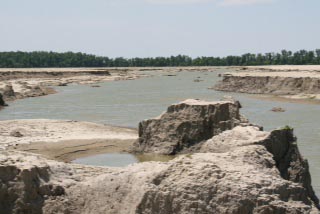University researchers study ‘once-in-a-generation flood’

Photo courtesy of Praveen Kumar
In May 2011, the Mississippi and Ohio Rivers flooded due to a manual breach of the levees of the Birds Point-New Madrid Floodway in southeastern Missouri. This is the aftermath that University civil engineering and geology researchers analyzed in their recently released study.
February 27, 2014
The largest flood along the Mississippi in 84 years has given University researchers a chance to compile a data set that’s unparalleled in the fields of civil engineering and geology.
In May 2011, the Mississippi and Ohio Rivers flooded due to a manual breach of the levees of the Birds Point-New Madrid Floodway in southeastern Missouri. In a Feb. 10 study published in the science journal “Environmental Science and Technology,” University researchers shared their findings on the rare flood, and showed how people in that area can better prepare for floods.
“This was a major opportunity to study a large flood, a flood like this hadn’t happened since 1927, so it was a once-in-a-generation flood,” said Praveen Kumar, the project director of the study and a professor of civil and environmental engineering at the University. “Also, we were able to get support from various funding agencies in order to measure various characteristics of the flood. That kind of a data set has never been collected before.”
This flood was induced by the U.S. Army Corps of Engineers in order to prevent a much more treacherous outcome of extreme upstream and downstream flooding of the Mississippi River.
“A mark of the significance of flood in general is that it was the first time that all three of the U.S. Army floodways were utilized in the same flood. It was a giant test of the whole levee flood system,” said Allison Goodwell, graduate research assistant and lead author of the study.
Get The Daily Illini in your inbox!
Data collection, as well as collaboration between the U.S. Army Corps of Engineers and different departments within the University, played a huge role in the research of the flood. Bruce Rhoads, a professor of geography and geographic information science, also contributed heavily to the study.
As an expert on the effects of floods and erosion on floodplains, Rhoads said he “helped to frame the study theoretically within the context of past work on the effects of extreme floods on floodplains, including past floods along the Mississippi River.”
Rhoads interpreted and identified the cause of erosion and deposition surrounding the Birds Point-New Madrid Floodway during the flood that occurred in 2011.
“Under climate change the frequency of such events could be different. Being prepared for such events is important, so by identifying the consequences associated with this flood analysis we can potentially predict all the measures that can be taken to mitigate all these kind of vulnerabilities,” said Kumar.
Although the flood did cause erosion and damage to surrounding areas, its consequences will serve to better prepare communities for potential floods, Goodwell said.
“We realized the importance of forested vegetation in the floodways as a possible mitigation measure,” she said. “Overall, I think the flood really demonstrated how levees in combination with other flood control measures are really useful in saving the valuable cities and areas.”
Meghan can be reached at [email protected].






